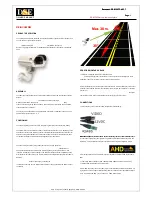
1-5
Setting and Operating Outline
1
[2] Configuration of the setting conditions
Operating
conditions
System
conditions
Object
type 00
Measuring
conditions
Object
type 01
・
・
・
Same for "Measurement 00."
Camera
1 and 2
Camera 1
and NG
images
The numbers in parentheses ( ) are page numbers for your reference.
Output monitor (2-2), image capture (2-4), message display (2-5), pattern
display (2-6), binary image display (2-7),
q
angle correction image display (2-
8), operation main display (2-9), evaluation change display (2-10), PC monitor
screen (2-11), through display (2-11), extension functions (2-12).
- I/O conditions (21-1)
Measurement start input I/F, parallel input X6, parallel input X7, strobe output
- Object type manual change (2-14)
- Communication setting (22-1)
Communication standard, communication speed, data length, parity, stop bit,
station number
- Computer link (23 -1)
Manufacturer, station number, top line of the written results
- Gain/offset (2-15)
- System time (2-16)
- Camera setting (2-17)
Camera selection, image capture mode
Same for Camera 1 and 2. However,
"Measurement 0, Camera 2" is not
available.
Measurement 0,
camera 1
Measurement 0,
camera 2
Measurement 1
Measurement 2
Measurement 3
Measurement 4
Image pre-
processing (3-20)
Input and output for
each object type
System for
each object
Measuring program
Positional deviation
measurement
-
Positional deviation measurement, degree of match
inspection, lead inspection, BGA/CSP inspection,
area measurement by binary conversion, object
counting by binary conversion, object identification
by binary conversion, color evaluation, color
unevenness inspection, color position
measurement, point measurement, multiple
positions measurement, multiple degree of match
inspection, fault inspection.
CCD trigger (21-18), shutter speed (3-37), serial
output (21-24, 26), calibration setting (21-28).
Monitor light level (3-35), register NG images (3-39),
stop NG measurement (3-40), whole group move (3-
41)
-
See Chapter 4
See
Chapters
4 to 17.














































